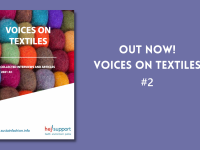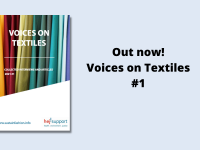Recycled Wool

Wool is a versatile, natural fiber that is used to produce a variety of clothing products, from active wear to formal garments.1 It is a relatively sustainable fiber due to its sourcing, long service life and biodegradability. However, several steps in the wool production process can cause pollution and harmful emissions. While the market share of recycled wool is quite low, its use can reduce the adverse environmental impacts related to the production of fabrics made from virgin wool.2
Wool recycling can be achieved in several ways, including the following routes:
- Open-loop system: wool textiles are used to produce new textiles that are often of lower quality (i.e., downcycling) than the original garment;3 the final products are typically used to make industrial items such as mattress padding or insulation.3
- Closed-loop system: wool textiles are returned to their original fiber state (i.e., a mechanical process involving multiple steps), and these fibers are turned into yarn again to create new products;3 this system produces textiles that are of similar quality and use to the original garments, such as knitwear.3
- Re-engineering: this involves the conversion of wool textiles into new items with different purposes (i.e., turning a wool sweater into a bag) or utilizing sidestreams and/or by-products in wool production waste to produce new products.3
Additionally, the amount of dye required to manufacture a new wool garment from recycled wool is further reduced. This mitigates the environmental impact of fabric production since the dyeing process in particular is responsible for high energy consumption and chemicals use.4
The use of recycled wool also eliminates a variety of other environmental impacts that are incurred from the use of virgin wool in fabric production. These adverse impacts include methane emissions innately produced by sheep, and the water pollution that results from washing untreated wool (i.e., dirt and animal sweat salts) .1
Another application of recycled wool involves the generation of new mixed fabrics by combining and blending it with other fibers. Although this can be seen as a useful practice, it limits the ability of further recycling of the wool in the fabric since the challenge of recycling mixed fabrics (i.e., extraction and separation of specific fibers) remains to be a difficult process.5
Despite its currently limited use, several major retailers such as Ralph Lauren and Target have committed to using recycled wool in their textiles, along with other types of preferred wool including organically-sourced wool.2
The positive impacts of using recycled wool demonstrate how decreasing the need for raw materials in manufacturing can help in the sustainable use of such natural fibers.
For more information on recycled wool, please refer to the Recycled Wool: A Primer for Newcomers & Discoverers report by the European Outdoor Group and Greenroom Voice.
For more information on the recycling of mixed fibers, please see our post: https://sustainfashion.info/closed-loop-for-textiles-is-the-way-forward-still-an-unfulfilled-dream/
References
- Wiedemann, S.G., Biggs, L., Nebel, B., Bauch, K., Laitala, K., Klepp, I.G., Swan, P.G., & Watson, K. (2020). Environmental impacts associated with the production, use, and end-of-life of a woollen garment. The International Journal of Life Cycle Assessment, 25, 1486-1499. Retrieved from: https://link.springer.com/article/10.1007%2Fs11367-020-01766-0
- Opperskalski, S., Siew, S., Tan, E., & Truscott, L. (2020). Preferred fiber & materials market report 2020. Textile Exchange. Retrieved from: https://textileexchange.org/wp-content/uploads/2020/06/Textile-Exchange_Preferred-Fiber-Material-Market-Report_2020.pdf
- International Wool Textile Organisation. (n.d.). Recycled wool. Retrieved from: https://iwto.org/sustainability/recycled-wool/#:~:text=Wool%20has%20been%20widely%20recycled,particularly%20suitable%20for%20wool%20knitwear).
- Bamonti, S., Spinelli, R., & Bonoli, A. (2016). Environmental footprint in the production of recycled wool. Environmental Engineering and Management Journal, 15(9), 1923-1931. Retrieved from: https://web.a.ebscohost.com/abstract?direct=true&profile=ehost&scope=site&authtype=crawler&jrnl=15829596&asa=Y&AN=119925329&h=XgdlirJKD7CkK6cnjgLZSNLE0C%2bcRFX4FWO8V9lPvlqvVYkK2H2mNNE8EnN4e30yyv3bVCa8pE9BJoRx23s4Jg%3d%3d&crl=c&resultNs=AdminWebAuth&resultLocal=ErrCrlNotAuth&crlhashurl=login.aspx%3fdirect%3dtrue%26profile%3dehost%26scope%3dsite%26authtype%3dcrawler%26jrnl%3d15829596%26asa%3dY%26AN%3d119925329
- Ravasio, P., & Rodewald, A. (2018, April). Recycled wool: A primer for newcomers and discoverers. European Outdoor Group and Greenroom Voice. Retrieved from: https://global-uploads.webflow.com/5ed628f951e6c112227290bb/5f3819d90d27c906a6a13208_FINAL%20-%20EOG%20Recycled%20Wool%20Report.pdf






